{{Translation memory A A translation memory

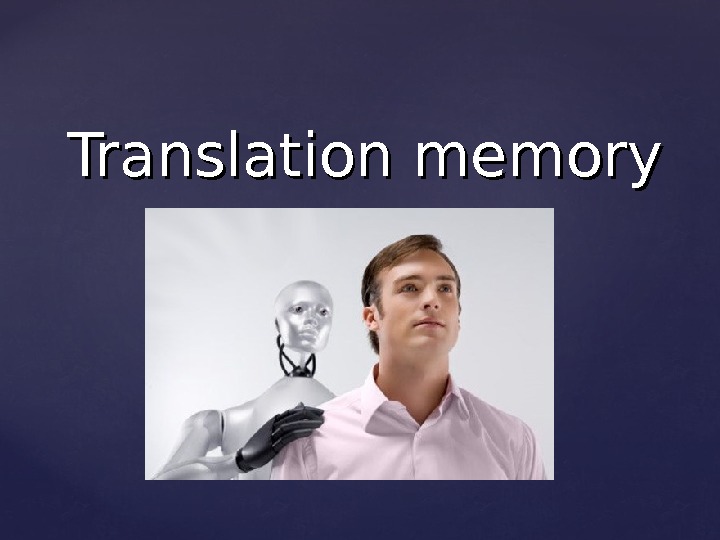
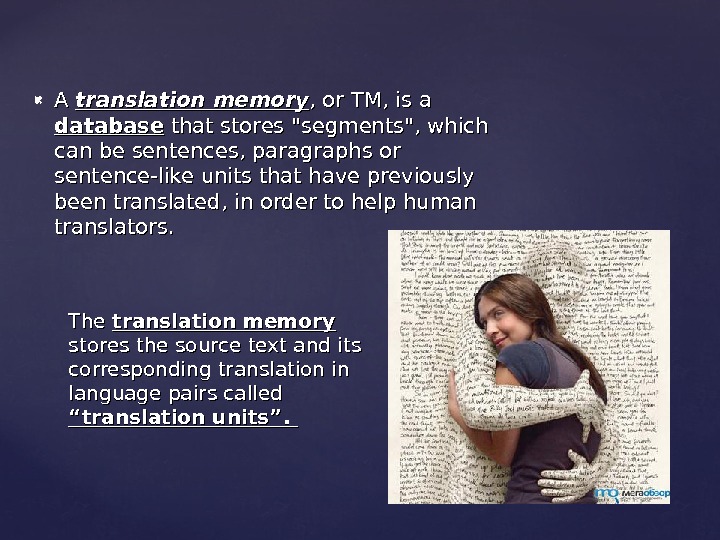
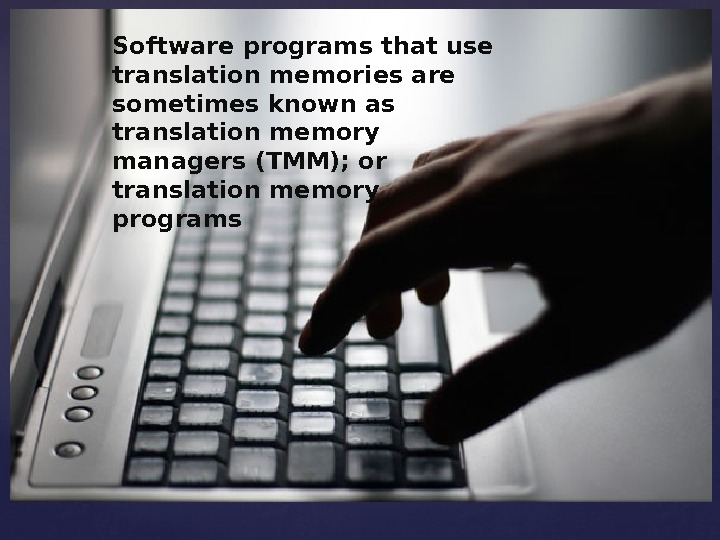
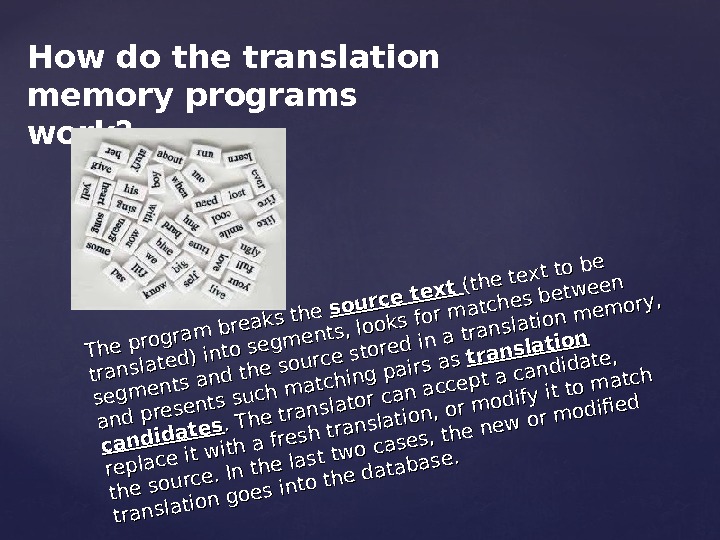
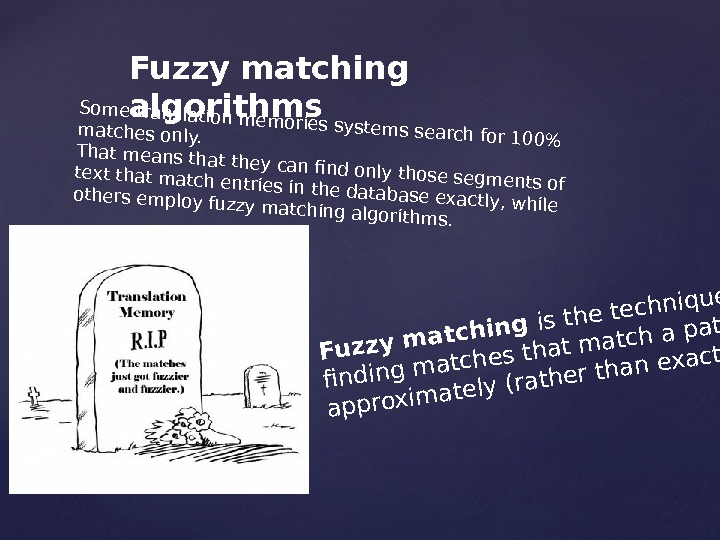
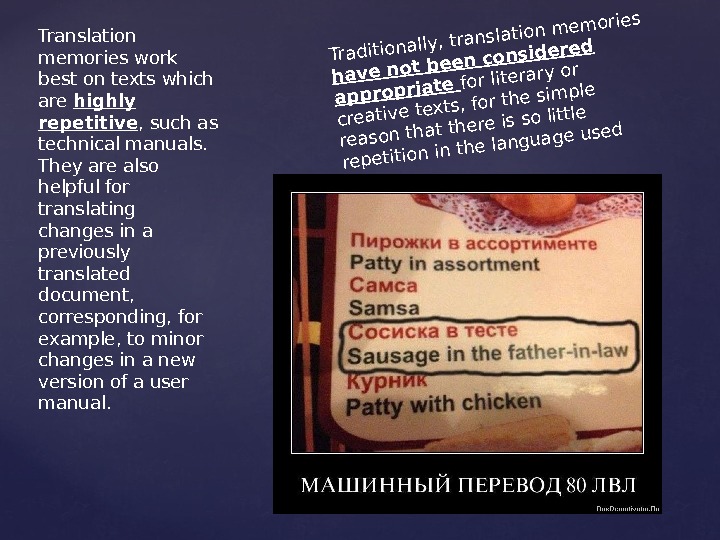
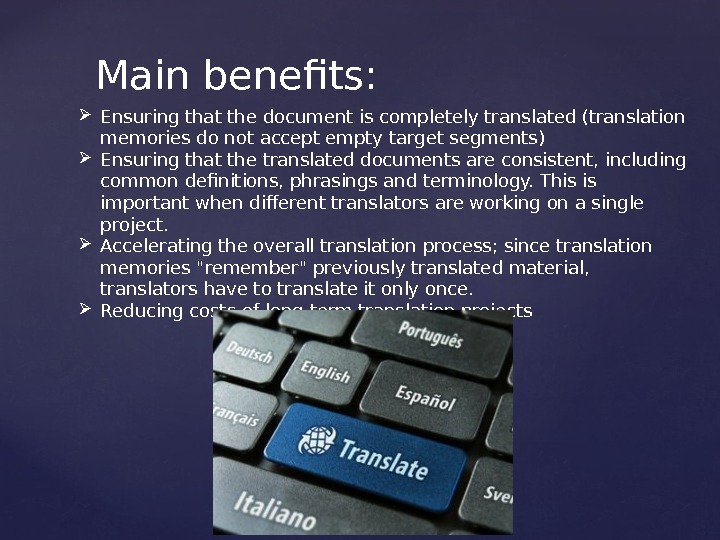
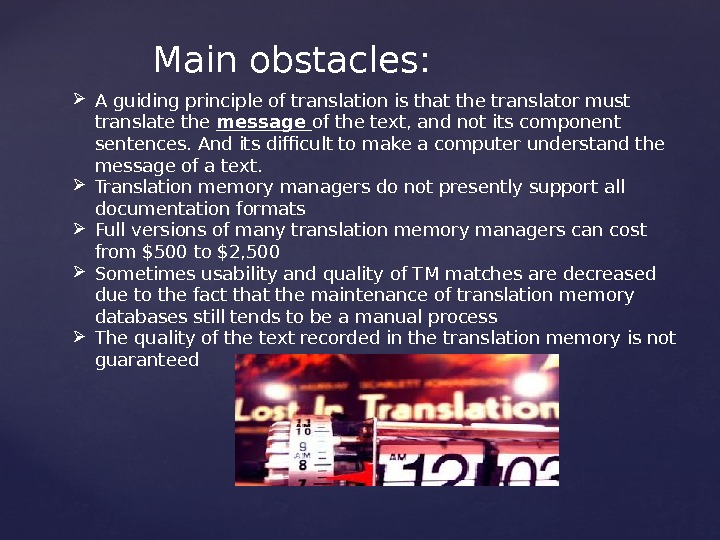
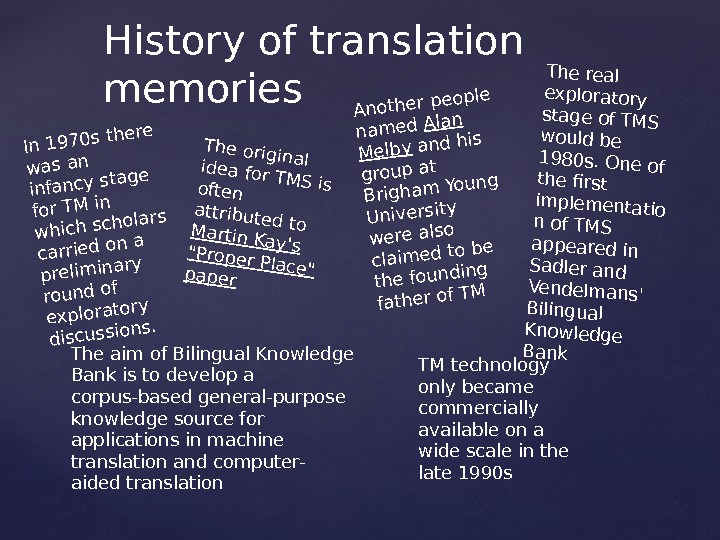
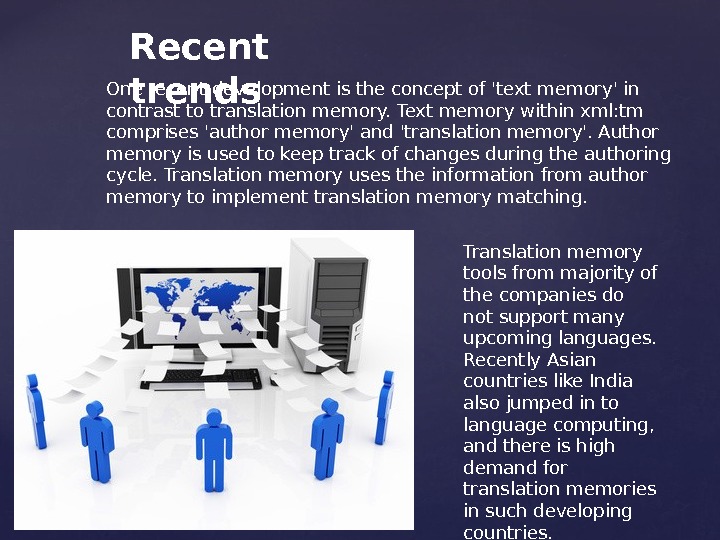
- Размер: 2.7 Mегабайта
- Количество слайдов: 10
Описание презентации {{Translation memory A A translation memory по слайдам
 {{Translation memory
{{Translation memory
 A A translation memory , or TM, is a database that stores «segments», which can be sentences, paragraphs or sentence-like units that have previously been translated, in order to help human translators. The translation memory stores the source text and its corresponding translation in language pairs called “translation units”.
A A translation memory , or TM, is a database that stores «segments», which can be sentences, paragraphs or sentence-like units that have previously been translated, in order to help human translators. The translation memory stores the source text and its corresponding translation in language pairs called “translation units”.
 Software programs that use translation memories are sometimes known as translation memory managers (TMM); or translation memory programs
Software programs that use translation memories are sometimes known as translation memory managers (TMM); or translation memory programs
 The program breaks the source text (the text to be translated) into segments, looks for matches between segments and the source stored in a translation memory, and presents such matching pairs as translation candidates. The translator can accept a candidate, replace it with a fresh translation, or modify it to match the source. In the last two cases, the new or modifed translation goes into the database. How do the translation memory programs work?
The program breaks the source text (the text to be translated) into segments, looks for matches between segments and the source stored in a translation memory, and presents such matching pairs as translation candidates. The translator can accept a candidate, replace it with a fresh translation, or modify it to match the source. In the last two cases, the new or modifed translation goes into the database. How do the translation memory programs work?
 Some translation memories systems search for 100% matches only. That means that they can fnd only those segments of text that match entries in the database exactly, while others employ fuzzy matching algorithms. Fuzzy matching algorithms Fuzzy matching is the technique of fnding matches that match a pattern approximately (rather than exactly).
Some translation memories systems search for 100% matches only. That means that they can fnd only those segments of text that match entries in the database exactly, while others employ fuzzy matching algorithms. Fuzzy matching algorithms Fuzzy matching is the technique of fnding matches that match a pattern approximately (rather than exactly).
 Translation memories work best on texts which are highly repetitive , such as technical manuals. They are also helpful for translating changes in a previously translated document, corresponding, for example, to minor changes in a new version of a user manual. Traditionally, translation memories have not been considered appropriate for literary or creative texts, for the simple reason that there is so little repetition in the language used
Translation memories work best on texts which are highly repetitive , such as technical manuals. They are also helpful for translating changes in a previously translated document, corresponding, for example, to minor changes in a new version of a user manual. Traditionally, translation memories have not been considered appropriate for literary or creative texts, for the simple reason that there is so little repetition in the language used
 Main benefts: Ensuring that the document is completely translated (translation memories do not accept empty target segments) Ensuring that the translated documents are consistent, including common defnitions, phrasings and terminology. This is important when different translators are working on a single project. Accelerating the overall translation process; since translation memories «remember» previously translated material, translators have to translate it only once. Reducing costs of long-term translation projects
Main benefts: Ensuring that the document is completely translated (translation memories do not accept empty target segments) Ensuring that the translated documents are consistent, including common defnitions, phrasings and terminology. This is important when different translators are working on a single project. Accelerating the overall translation process; since translation memories «remember» previously translated material, translators have to translate it only once. Reducing costs of long-term translation projects
 Main obstacles: A guiding principle of translation is that the translator must translate the message of the text, and not its component sentences. And its difficult to make a computer understand the message of a text. Translation memory managers do not presently support all documentation formats Full versions of many translation memory managers can cost from $500 to $2, 500 Sometimes usability and quality of TM matches are decreased due to the fact that the maintenance of translation memory databases still tends to be a manual process The quality of the text recorded in the translation memory is not guaranteed
Main obstacles: A guiding principle of translation is that the translator must translate the message of the text, and not its component sentences. And its difficult to make a computer understand the message of a text. Translation memory managers do not presently support all documentation formats Full versions of many translation memory managers can cost from $500 to $2, 500 Sometimes usability and quality of TM matches are decreased due to the fact that the maintenance of translation memory databases still tends to be a manual process The quality of the text recorded in the translation memory is not guaranteed
 History of translation memories. In 1970 s there was an infancy stage for TM in which scholars carried on a preliminary round of exploratory discussions. The original idea for TMS is often attributed to Martin Kay’s «Proper Place» paper Another people named Alan Melby and his group at Brigham Young University were also claimed to be the founding father of TM The real exploratory stage of TMS would be 1980 s. One of the frst implementatio n of TMS appeared in Sadler and Vendelmans’ Bilingual Knowledge Bank The aim of Bilingual Knowledge Bank is to develop a corpus-based general-purpose knowledge source for applications in machine translation and computer- aided translation TM technology only became commercially available on a wide scale in the late 1990 s
History of translation memories. In 1970 s there was an infancy stage for TM in which scholars carried on a preliminary round of exploratory discussions. The original idea for TMS is often attributed to Martin Kay’s «Proper Place» paper Another people named Alan Melby and his group at Brigham Young University were also claimed to be the founding father of TM The real exploratory stage of TMS would be 1980 s. One of the frst implementatio n of TMS appeared in Sadler and Vendelmans’ Bilingual Knowledge Bank The aim of Bilingual Knowledge Bank is to develop a corpus-based general-purpose knowledge source for applications in machine translation and computer- aided translation TM technology only became commercially available on a wide scale in the late 1990 s
 Recent trends. One recent development is the concept of ‘text memory’ in contrast to translation memory. Text memory within xml: tm comprises ‘author memory’ and ‘translation memory’. Author memory is used to keep track of changes during the authoring cycle. Translation memory uses the information from author memory to implement translation memory matching. Translation memory tools from majority of the companies do not support many upcoming languages. Recently Asian countries like India also jumped in to language computing, and there is high demand for translation memories in such developing countries.
Recent trends. One recent development is the concept of ‘text memory’ in contrast to translation memory. Text memory within xml: tm comprises ‘author memory’ and ‘translation memory’. Author memory is used to keep track of changes during the authoring cycle. Translation memory uses the information from author memory to implement translation memory matching. Translation memory tools from majority of the companies do not support many upcoming languages. Recently Asian countries like India also jumped in to language computing, and there is high demand for translation memories in such developing countries.

